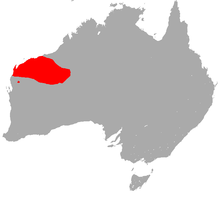Little red kaluta
| Little red kaluta | |
|---|---|
| Scientific classification | |
| Domain: | Eukaryota |
| Kingdom: | Animalia |
| Phylum: | Chordata |
| Class: | Mammalia |
| Infraclass: | Marsupialia |
| Order: | Dasyuromorphia |
| Family: | Dasyuridae |
| Subfamily: | Dasyurinae |
| Tribe: | Dasyurini |
| Genus: | Dasykaluta Archer, 1982 |
| Species: | D. rosamondae
|
| Binomial name | |
| Dasykaluta rosamondae (
Ride , 1964) | |

| |
| Little Red Kaluta range | |
The little red kaluta (Dasykaluta rosamondae) is a small, reddish-brown, shrew-like mammal native to dry grasslands of northwest Australia. It is active at night, feeding on insects and other small animals. The kaluta is a marsupial and is the only member of its genus, Dasykaluta. Individuals are around 10 cm (3.9 in) long and weigh from 20 to 40 g (0.71 to 1.41 oz). They live for about four years in captivity. Other common names include little red antechinus, russet antechinus and spinifex antechinus.[2]
Taxonomy
Dasykaluta rosamondae is a member of the family
The earliest specimen was collected in 1936 by Mr. R. M. W. Bligh near Tambourah (Marble Bar) and deposited at the
"Kaluta" is an Aboriginal name adopted from the Nyamal language for this species, and this is reflected in the generic name Dasykaluta, which means "hairy kaluta". The species name, rosamondae, is a threefold reference to Rosamund Clifford, the famous mistress of Henry II of England, who is said to have had red hair, its spinifex dominated habitat resembling "a house of wonderful working, so that no man or woman might come to her ...", alluding to a maze at Woodstock Palace where the king hid her and the place of the species discovery, Woodstock Station.[3][6]
Description
The kaluta is a rufous brown colour with fairly coarse fur. In body shape, it is generally similar to the antechinuses, although it has a shorter head and ears. It is also somewhat smaller than these animals.[6] The species is small and robust in form, with a shaggy appearance to the uniformly russet-brown or coppery colour at the upper parts of the body; the underparts are a paler shade of the colour above. The head and body measurement is 90 to 105 millimetres (3.5 to 4.1 in). Ears are short and covered in fur, a little higher than the top of the head and 11–13 mm (0.43–0.51 in) in length; the tip of the short snout is closer to the eyes than the ears. Their tail is relatively thick and short, from 55 to 75 mm (2.2 to 3.0 in), sometimes swollen toward the base and tapers to a length not greater than two-thirds of the body length. Kaluta has hind feet that measure 15–18 mm (0.59–0.71 in) long and covered in fur.[2]
The little red kaluta feeds on insects and small vertebrates. A notable habit is flicking its tail in the air as it investigates its habitat.[6]
Male little red kalutas, like several other
Habitat and behaviour
The little red kaluta is moderately common in the
References
- . Retrieved 12 November 2021.
- ^ ISBN 9780195573954.
- ^ . The Western Australian Naturalist. 9 (3): 58–65.
- ^ Dasykaluta rosamondae (Ride, 1964). — Archer, M. 1982. Review of the dasyurid (Marsupialia) fossil record, integration of data bearing on phylogenetic interpretation, and suprageneric classification. pp. 397-443 in Archer, M. (ed.). Carnivorous Marsupials. Sydney : Royal Zoological Society of New South Wales Vol. 2 i-iv, 407 pp.
- OCLC 62265494.
- ^ ISBN 0-7301-0484-2.

